Dates:
Location:
Virtual ExhibitionVirtual Exhibit
Selected Works
Today, Bowdoin women, including students, faculty, staff, and honorary degree holders, continue to work in and study the North, involved in disciplines ranging from archaeology to oceanography.
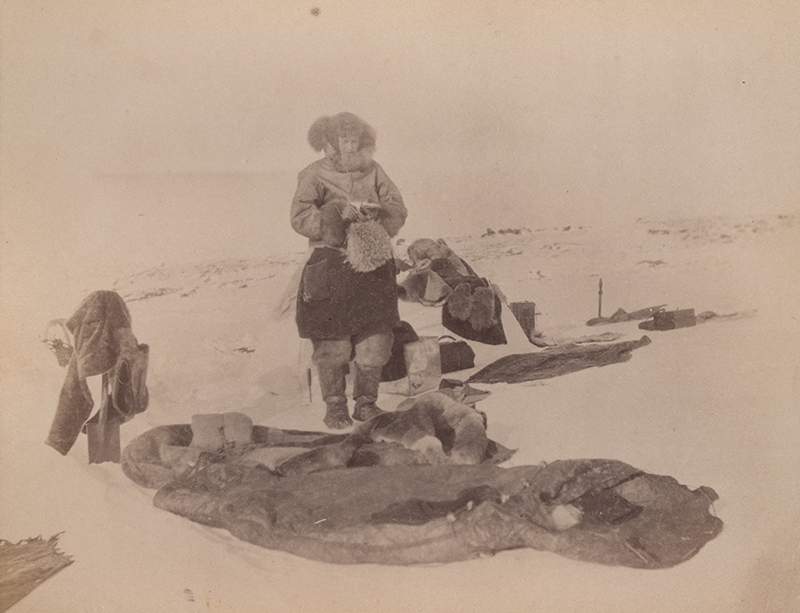
Josephine Peary in the North
Josephine Diebitsch Peary, the wife of Robert E. Peary, Class of 1877, was a woman of many talents who supported her husband’s Arctic career both at home and in the north. Jo overwintered in the Arctic three times and gave birth to their daughter Marie there in 1893. Undaunted by Arctic weather, she made a point of going out walking or snowshoeing nearly every day and developed a unique outfit that kept her warm while preserving her modesty.
Unidentified photographer, possibly R.E. Peary, Josephine Peary at a campsite, northwestern Greenland, 1891-92. Digital print from albumen original. Museum purchase.
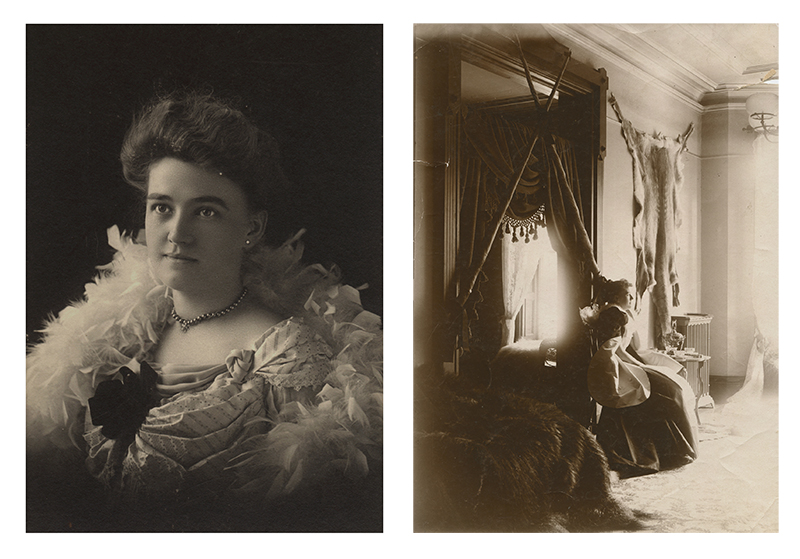
Josephine Peary at Home
At home in the United States, Josephine was a stylish figure, often called on to promote her absent husband’s work. She decorated the family home with souvenirs of their Arctic travels, a reminder to visitors of her adventurous spirit and of her support of her husband’s dream to reach the North Pole. She wrote books and overcame her shyness to deliver public lectures and meet with influential businessmen to raise money for her husband’s expeditions.
Unidentified photographer, Josephine Peary at home with Arctic décor, possibly Brooklyn, ca. 1900. Digital print from gelatin silver original. Gift of Wendy L. Noyes.
G.V. Buck, Josephine Diebitsch Peary, Washington, D.C., ca. 1890. Digital print from gelatin silver original. Gift of Wendy L. Noyes.
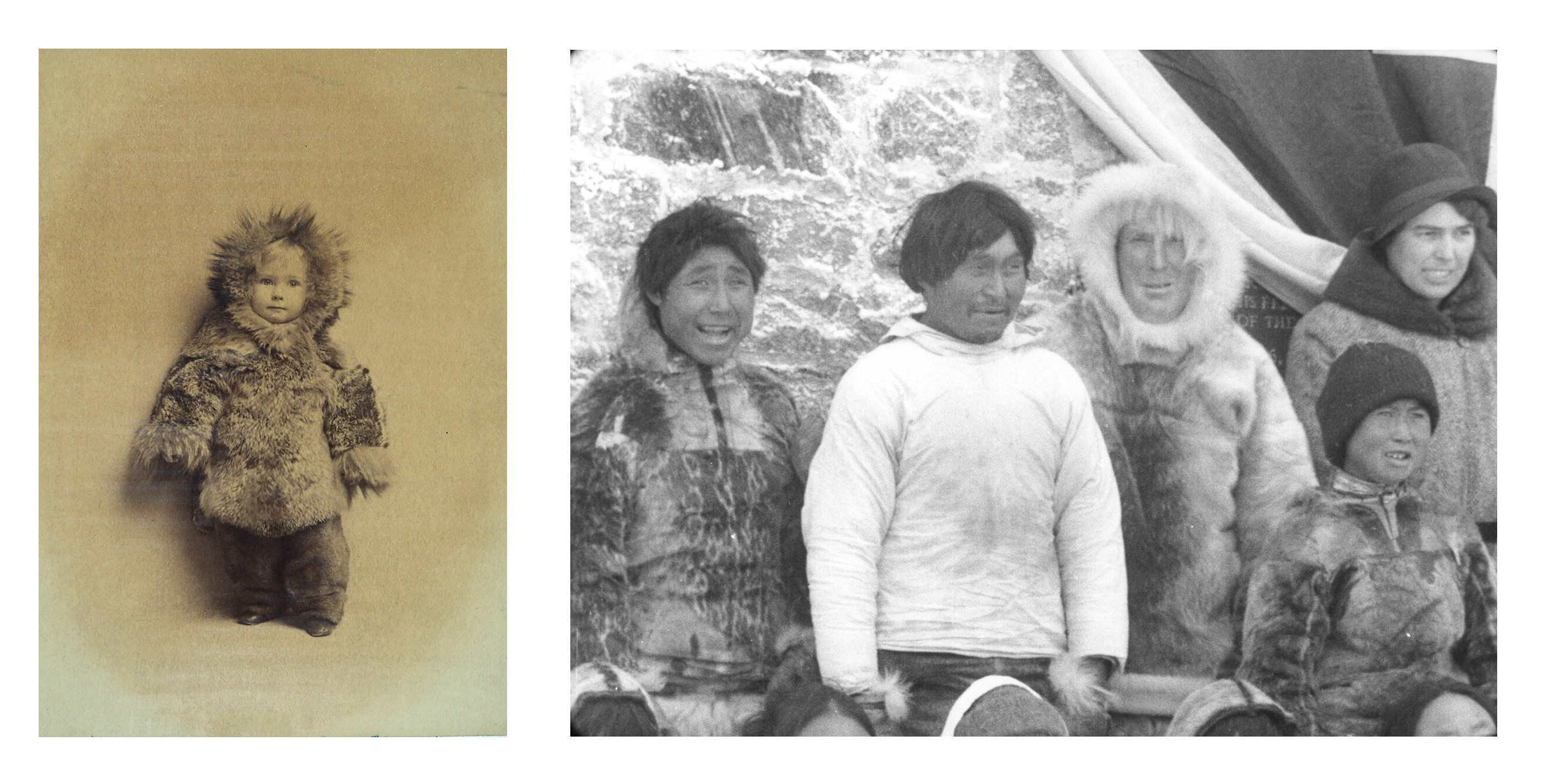
Marie Ahnigito Peary
Born in northwestern Greenland in September 1893, Marie Peary, also known as “the Snow Baby,” made several trips to the Arctic as a child. She and Captain Robert A. Bartlett led an expedition to construct a monument to her father, Robert E. Peary, at Cape York, northwest Greenland, in 1932. She was a fierce defender of her father’s legacy and wrote and lectured widely on Arctic topics, receiving many honors and accolades for her work.
Moses P. Rice, Marie Ahnigito Peary, Washington, D.C., 1893. Digital print from albumen original. Gift of Louise Minot.
Reginald Wilcox, (l-r) Qissuk, Odak, Robert A. Bartlett, unidentified woman, Marie Peary, Cape York, Greenland, 1932. Digital print from motion picture film frame. Gift of David Nutt, Jr.
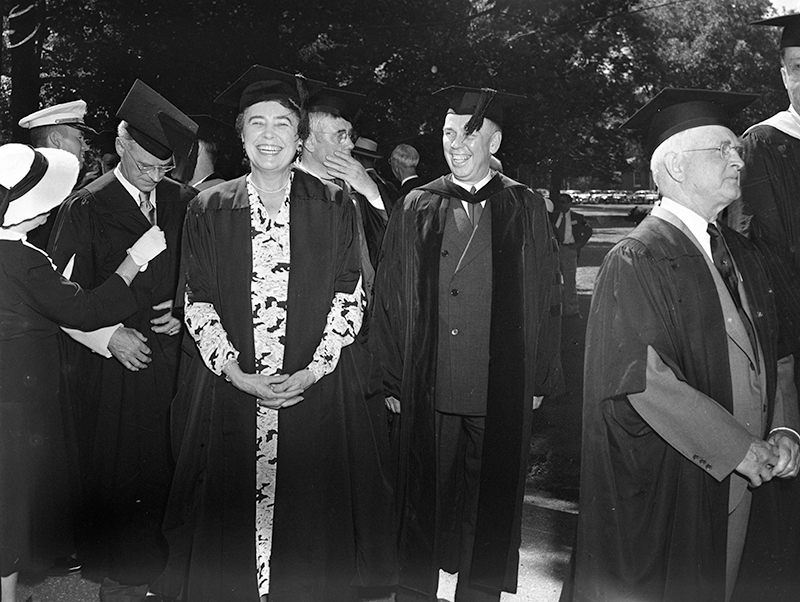
Marie Peary Stafford, MA (Hon)
In 1949 Bowdoin College awarded Marie an honorary degree with these words:
“MARIE PEARY STAFFORD, of Washington, daughter, sister, mother of Bowdoin men, known in her youth as the Snow Baby and still holding the record of the most northerly born white child in the world; President of the International Society of Women Geographers; interesting author and brilliant lecturer, displaying the daring of her father and the vivacity and charm of her mother; fittingly honored this year on the fortieth anniversary of Peary’s discovery of the Pole; always a loyal daughter of Bowdoin and now a formal member of the family.
Honoris Causa, MASTER OF ARTS”
Unidentified photographer, Samuel L. Forsaith (Bowdoin h. 1949), Ralph Brewster (Owen) (Bowdoin 1909), and Marie Peary Stafford (Bowdoin h. 1949), Local call number 6.1.13, Brunswick, 1949. Bowdoin College Archives, Brunswick, Maine.
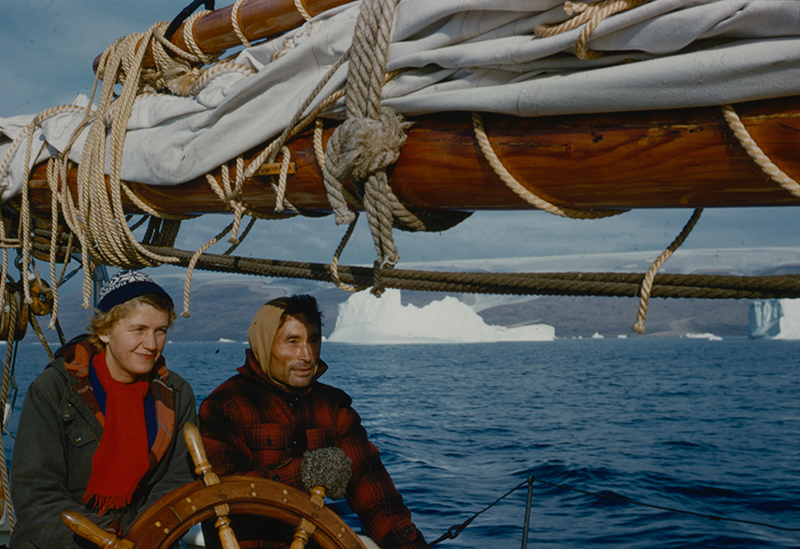
Miriam Look MacMillan
Miriam Look, seen here aboard the Bowdoin with Kali Peary at the wheel, married Donald B. MacMillan, Class of 1898, in 1935 and soon became an essential member of his expeditions. She was an avid sailor and quickly came to love the Arctic, making nine trips north until the couple retired from Arctic voyages in 1954. She continued to oversee Donald MacMillan’s legacy, working closely with the Arctic museum before and after its opening in 1967.
Edward K. Morse, Kali Peary and Miriam MacMillan at the wheel, northwestern Greenland, 1947. Digital print from Kodachrome transparency. Gift of Dr. Edward K. Morse.
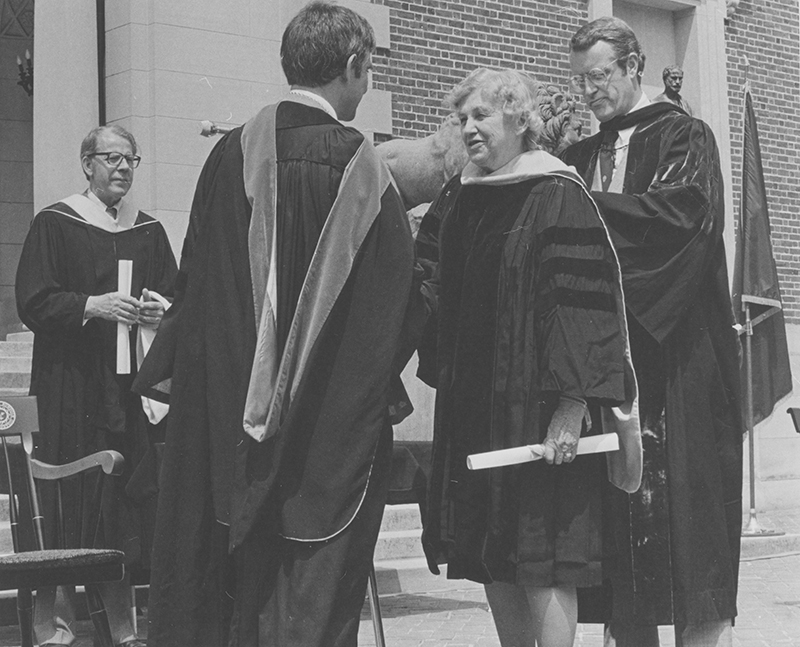
Miriam Look MacMillan, Sc.D (Hon)
In 1980 the College awarded Miriam an honorary degree, marking her authorship of a book about her experiences in the North, Green Seas and White Ice, and her important role in preserving Donald MacMillan’s legacy. The description of her accomplishments concluded, “she has labored generously for the good of the College and has provided invaluable guidance in the growth of its Arctic collections; a person of spirit and kindliness, she has won the respect of all who treasure the quality of courage.”
Unidentified photographer, Miriam MacMillan receiving her honorary degree from President Enteman, Brunswick, 1980. Digital print from gelatin silver original. Gift of Miriam Look MacMillan.
![In-you-gee-to and family (Inukitsorujuk, Tukummek and children). Inah-wah-o [Inugarssuk]. Alning-wa on the Erik [Arnaguaq].](images/tukum-inugar-arnan.jpg)
Tukummeq, Inugarssuk, and Arnanguaq
Inuit women were important but often unrecognized members of many expeditions. Tukummeq, Inugarssuk, and Arnanguaq were just three of the many women who sewed fur clothing for American expedition members. Along with their husbands, these women worked first for Peary and later for MacMillan. Without the warm, waterproof clothes sewn by these women, the long hunting and exploration trips the men undertook would not have been possible.
Donald B. MacMillan, In-you-gee-to and family (Inukitsorujuk, Tukummek and children), Etah, Greenland, 1925. Digital print from gelatin silver original. Gift of Donald and Miriam MacMillan.
Donald B. MacMillan, Inah-wah-o [Inugarssuk], northwestern Greenland, May 1917. Digital print from gelatin silver original. Gift of Margaret Tanquary Corwin.
Donald B. MacMillan or George Borup, Alning-wa on the Erik [Arnaguaq], northwestern Greenland, 1909. Digital print from gelatin silver original. Gift of Donald and Miriam MacMillan.
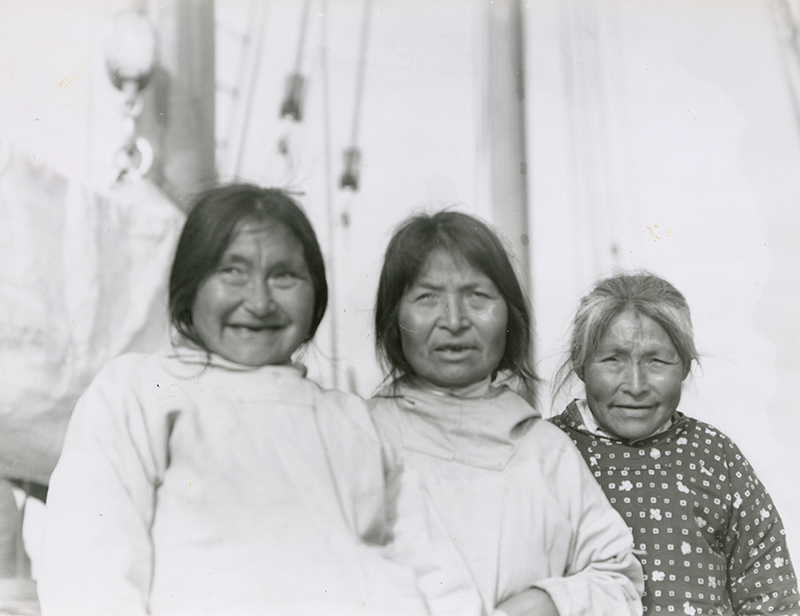
North Pole Reunion
On his later summer voyages to the North, MacMillan reconnected with many of the people with whom he had worked over the years. On his last trip in 1954, he was delighted to visit Tukummeq, Inugarssuk, and Arnanguaq. Although the wider world was, and remains, largely unaware of the women’s significant contributions to the success of many expeditions, MacMillan and Peary were enthusiastic in their praise of these talented individuals and their work.
Donald B. MacMillan, Three Polar Eskimo (Inughuit) women who were with Peary on North Pole Expedition (Tukummeq, Inugarssuk, Arnanguaq), northwestern Greenland, 1954. Digital print from gelatin silver original. Gift of Donald and Miriam MacMillan.
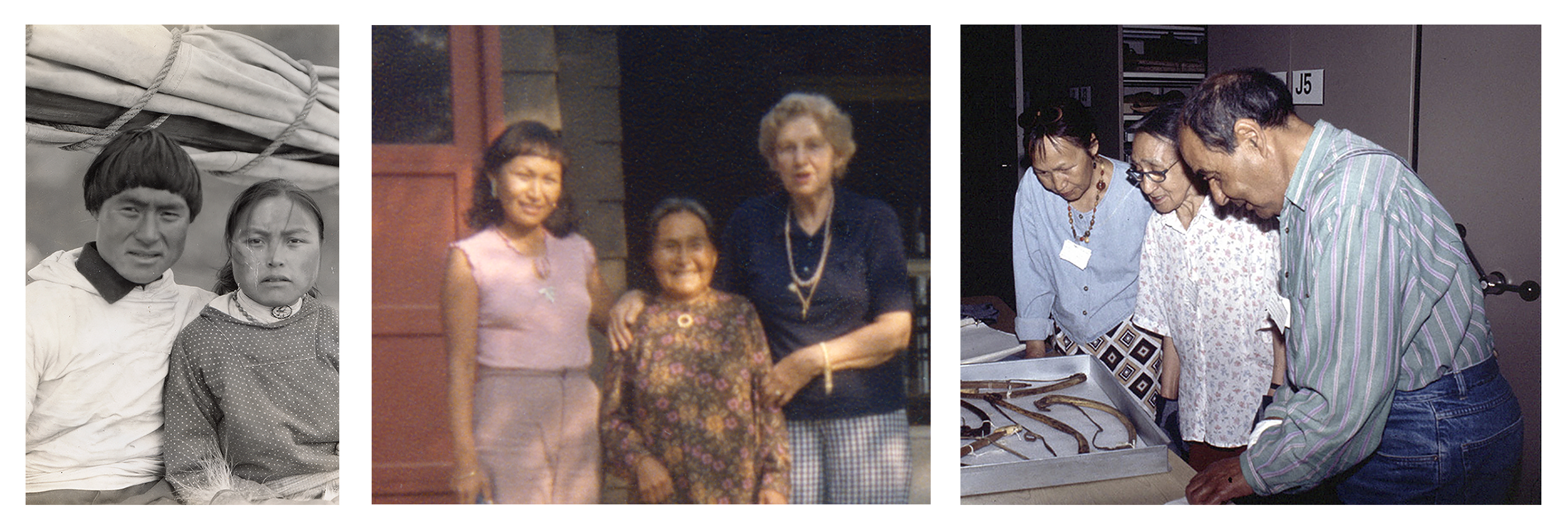
Connections Across Generations
Only one of the women who worked with MacMillan in the Arctic ever travelled south. Amaunalik, seen here aboard the Bowdoin with her husband Qavigaaq, first worked with MacMillan when he overwintered in Greenland in 1923-24. In 1979 she came to Bowdoin with her daughter Navarana and son-in-law Kenn Harper, and visited with Miriam MacMillan at her home in Owl’s Head. In 2001, Navarana, along with her sister Balika and brother-in-law Magssanguaq Jensen, visited Bowdoin again to examine collections here and at the American Museum of Natural History in New York.
Donald B. MacMillan, Ki-wee-a and Ak-mow-neddy (Qaviagaaq and Amaunalik), Qamarfit, Greenland, 1924. Digital print from gelatin silver original. Gift of Donald and Miriam MacMillan.
Edward K. Morse, Navarana Harper, Amaunalik Qavigaaq and Miriam MacMillan (detail), Owl’s Head, Maine, 1979. Gift of Edward K. Morse.
Genevieve LeMoine, Navarana Qavigaaq, Balika Jensen and Magssanguaq Jensen, New York, 2001. Digital print. Arctic Museum collection.
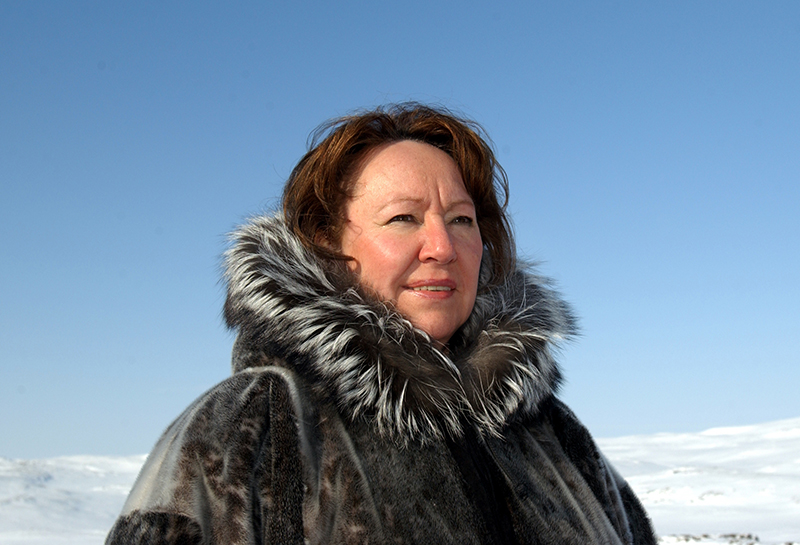
Sheila Watt-Cloutier L.H.D (Hon)
In 2009 the College awarded an honorary degree to Inuk environmentalist Sheila Watt-Cloutier. As chair of the Inuit Circumpolar Council, she played an important role in negotiations leading to the 2001 Stockholm Convention banning the use of persistent organic pollutants. In addition, she pioneered the idea that human-induced climate change is a violation of Inuit human rights. In 2010 she returned to campus as a Bowdoin Tallman scholar, teaching and working on her book The Right to Be Cold.
Stephen Lowe, Sheila Watt-Cloutier, Arctic Canada, ca. 2008. Digital print. Courtesy of Sheila Watt-Cloutier.

